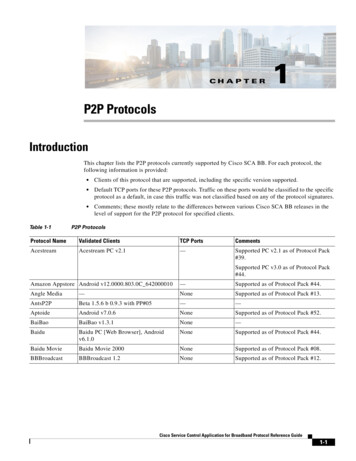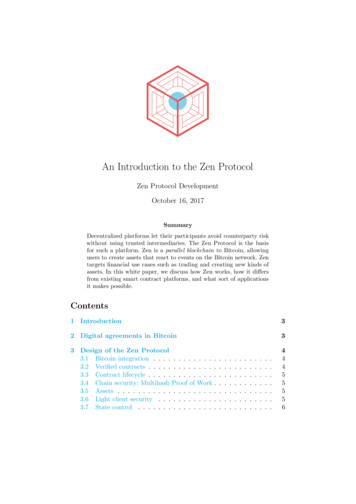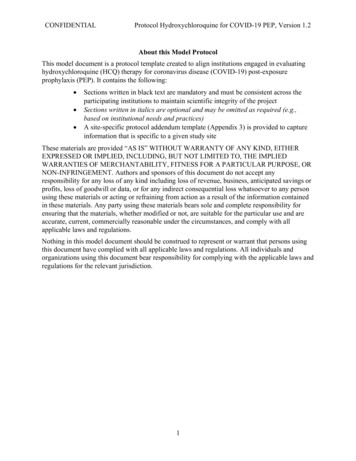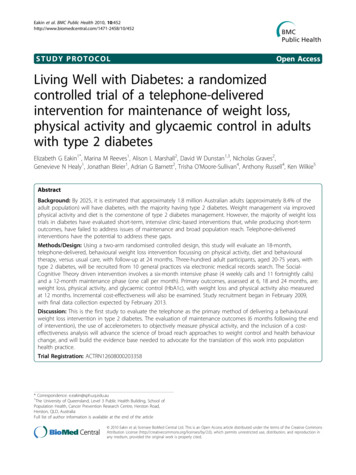
Transcription
Eakin et al. BMC Public Health 2010, 2STUDY PROTOCOLOpen AccessLiving Well with Diabetes: a randomizedcontrolled trial of a telephone-deliveredintervention for maintenance of weight loss,physical activity and glycaemic control in adultswith type 2 diabetesElizabeth G Eakin1*, Marina M Reeves1, Alison L Marshall2, David W Dunstan1,3, Nicholas Graves2,Genevieve N Healy1, Jonathan Bleier1, Adrian G Barnett2, Trisha O’Moore-Sullivan4, Anthony Russell4, Ken Wilkie5AbstractBackground: By 2025, it is estimated that approximately 1.8 million Australian adults (approximately 8.4% of theadult population) will have diabetes, with the majority having type 2 diabetes. Weight management via improvedphysical activity and diet is the cornerstone of type 2 diabetes management. However, the majority of weight losstrials in diabetes have evaluated short-term, intensive clinic-based interventions that, while producing short-termoutcomes, have failed to address issues of maintenance and broad population reach. Telephone-deliveredinterventions have the potential to address these gaps.Methods/Design: Using a two-arm randomised controlled design, this study will evaluate an 18-month,telephone-delivered, behavioural weight loss intervention focussing on physical activity, diet and behaviouraltherapy, versus usual care, with follow-up at 24 months. Three-hundred adult participants, aged 20-75 years, withtype 2 diabetes, will be recruited from 10 general practices via electronic medical records search. The SocialCognitive Theory driven intervention involves a six-month intensive phase (4 weekly calls and 11 fortnightly calls)and a 12-month maintenance phase (one call per month). Primary outcomes, assessed at 6, 18 and 24 months, are:weight loss, physical activity, and glycaemic control (HbA1c), with weight loss and physical activity also measuredat 12 months. Incremental cost-effectiveness will also be examined. Study recruitment began in February 2009,with final data collection expected by February 2013.Discussion: This is the first study to evaluate the telephone as the primary method of delivering a behaviouralweight loss intervention in type 2 diabetes. The evaluation of maintenance outcomes (6 months following the endof intervention), the use of accelerometers to objectively measure physical activity, and the inclusion of a costeffectiveness analysis will advance the science of broad reach approaches to weight control and health behaviourchange, and will build the evidence base needed to advocate for the translation of this work into populationhealth practice.Trial Registration: ACTRN12608000203358* Correspondence: e.eakin@sph.uq.edu.au1The University of Queensland, Level 3 Public Health Building, School ofPopulation Health, Cancer Prevention Research Centre, Herston Road,Herston, QLD, AustraliaFull list of author information is available at the end of the article 2010 Eakin et al; licensee BioMed Central Ltd. This is an Open Access article distributed under the terms of the Creative CommonsAttribution License (http://creativecommons.org/licenses/by/2.0), which permits unrestricted use, distribution, and reproduction inany medium, provided the original work is properly cited.
Eakin et al. BMC Public Health 2010, 2BackgroundType 2 diabetes - a population health problemThe rapid increase in the prevalence of type 2 diabetes,obesity and associated complications is a major publichealth problem. In Australia, data from the 1999-2000AusDiab study estimated that approximately 1 million(7.4%) Australian adults aged 25 years and over havetype 2 diabetes [1], with approximately 85% being overweight or obese [2]. The growing epidemics of type 2diabetes and obesity have been concurrent, with the prevalence of both doubling over the past 20 years [1]. Theprevalence of type 2 diabetes is predicted to increasedramatically over the next few decades; projections arethat by 2030, 8.4% Australian adults aged 20-79 willhave the disease [3]. Similar rapidly increasing prevalence estimates have been reported for the UK [3], USA[3,4] and other developed and developing countries [3].Identified as the seventh leading cause of death amongAustralian adults, type 2 diabetes is a major cause ofpremature mortality and morbidity due to cardiovascular, renal, ophthalmic and neurological disease [5]. Datafrom the DiabCost Australia study, which assessed thetotal costs of type 2 diabetes to the health care system,society, government and carers, estimated that 3 billiona year is spent treating type 2 diabetes [6]. Since theburden of illness associated with type 2 diabetesincreases with the onset of microvascular and macrovascular complications [6], there is high priority for effective and sustainable strategies to slow or prevent theonset of complications. The value of achieving glycaemiccontrol is underscored by the landmark findings of theUK Prospective Diabetes Study, a 10 year observationalfollow-up in patients with diabetes, whereby each 1%reduction in glycosylated haemoglobin (HbA1c) wasassociated with a 14% reduction in myocardial infarction, a 37% reduction in microvascular events, and a21% reduction in diabetes-related mortality [7]. This isof particular importance for people with type 2 diabetessince coronary heart disease is responsible for about70% to 80% of deaths in this population [8].Lifestyle factors that adversely affect energy balance(physical inactivity and over-nutrition) play a major rolein the development of both type 2 diabetes and obesity[9,10]. The importance of weight management, bymeans of a healthy, energy-restricted diet and a physically active lifestyle, is considered to be the primaryapproach in the treatment of overweight and obesity[11,12] and is widely acknowledged as a cornerstone ofthe management of type 2 diabetes and its related morbidities [13]. There is also evidence that many of thetraditional pharmacologic approaches frequently used totreat diabetes contribute to weight gain [14]. Weightloss or weight management is an important therapeuticPage 2 of 15task for most people with type 2 diabetes, not only forimproved glycaemic control but also for reducing cardiovascular disease (CVD) risk [13]. A modest weight lossof 5-10% of body weight has been associated withimprovements in fasting plasma glucose, HbA1c, insulin,lipid levels, and blood pressure [10]. In addition, there iscompelling epidemiologic and experimental evidencethat physical activity confers substantial protectionagainst CVD and premature mortality in those with type2 diabetes, independent of weight loss, through itsfavourable effects on blood pressure, blood glucose,insulin sensitivity, lipid profile, fibrinolysis, endothelialfunction and inflammatory defence systems [15,16].At present in Australia, type 2 diabetes is managedprimarily in the general practice setting (primary care).In addition to medication management and monitoringof glycaemic control, this may include brief lifestyleadvice from General Practitioners (GPs), and for some,a Diabetes Care Plan that includes referral for a limitednumber of visits to diabetes educators, dietitians, exercise physiologists and other allied health professionals.Given the challenge of health behaviour change andweight loss, and the need for ongoing assistance tomaintain such changes, approaches that work in concertwith primary care are needed, with such approachesinvolving more behaviourally-focussed and longer-termself-management supports [17].Lifestyle management and weight loss intervention trialsin type 2 diabetesThere is a large literature on lifestyle management andweight loss interventions in type 2 diabetes, including thecurrent landmark Look AHEAD trial, which is evaluatingan intensive four-year weight loss intervention to reducecardiovascular morbidity and mortality [18,19]. Acrossnumerous studies, there is clear evidence that intensive lifestyle interventions involving reduced energy (and fat)intake, regular physical activity, cognitive behaviourtherapy and frequent participant contact will produce significant behavioural improvements, as well as weight loss(5-7% of body weight) and concomitant improvements inglycaemic control and dyslipidaemia [10,20,21]. However,there are a number of gaps in this literature that make itsfindings less relevant to informing a population-basedapproach to the lifestyle management of type 2 diabetes.First, the majority of trials have evaluated intensive, clinicbased interventions that are similar to the diabetes education programs offered through hospitals as part of clinicalmanagement. While these clinic-based interventions areeffective [22], few patients with type 2 diabetes take part insuch programs [23]. Second, very few studies include apost-intervention follow-up assessment to determinewhether improvements are maintained longer term [24,25].
Eakin et al. BMC Public Health 2010, 2Page 3 of 15Broad reach weight loss and lifestyle intervention trialsSettingA number of recent studies have evaluated weight lossinterventions delivered via telephone, tailored print andthe internet [26-31]. Of note are two recent studieswhich have evaluated a telephone-delivered approach forinitiation and maintenance of weight loss [29,31]. Onestudy observed similar short-term weight loss at6-months for both face-to-face (8.9%) and telephonedelivered (7.7%) interventions [29]. In the other trial,following initial weight loss at 6 months, small but statistically non-significant regain in weight was observed forthose in the 12-month telephone and face-to-face maintenance contact groups, which was significantly less thanthe regain observed in the control group [31].Telephone-delivered interventions have the potentialfor widespread and cost-effective population reach, andhave been widely researched [32-38]. A systematic reviewof 26 telephone-delivered physical activity and dietarybehaviour intervention studies found very strong supportfor their efficacy to produce short-term behaviouralchanges in both people with and without chronic conditions, with 20 of 26 studies reporting significant behavioural improvements immediately post-intervention[39]. Interventions lasting six to 12 months and thoseincluding 12 or more calls produced the most favourableoutcomes. Our own work in this area has shown telephone-delivered interventions to be effective in promoting both initiation and maintenance [40,41] of dietarychange, as well as demonstrating cost-effectiveness [42].Participants are recruited from general practices in thecity of Logan (population 270,000), a large ethnicallyand socioeconomically diverse community in Queensland, Australia, which sits 35 kilometres from Brisbane(the state capital), and an urban centre of 1.8 millionresidents.Practice sampling and recruitmentGeneral practices are recruited from the Southeast Primary Health Care Network (SPHN), a state and federallyfunded organization that provides administrative, technical and professional development/educational support tolocal area practices. At study commencement, SPHNsupported 76 practices. The study will recruit 10 practices over two years, with approximately 30 adultsenrolled from each practice. To ensure an adequatepatient sampling frame from each practice, practices areranked in order of descending number of GPs, with thelargest practices approached first on a rolling basis until10 practices (or the required sample size of 300 participants) consent to participate. Practices are initially contacted by telephone to determine whether electronicmedical records can be used to perform patient searchesby medical condition, and whether approximately 200patients with type 2 diabetes can be identified. Eligiblepractices are sent an invitation letter and study brochure. This is followed-up by a phone call from a GPworking within the SPHN (author KW), and a practicevisit from the project manager to solicit consent.PurposeThis paper describes the methods of the Living Wellwith Diabetes trial which is evaluating a telephonedelivered behavioural weight loss intervention focussingon physical activity, diet and behavioural therapy inadults with type 2 diabetes. To promote maintenancethe 18 month intervention has an intensive first6 months focussed on initiation of behaviour change,followed by 12 months focussed on enhancing/supporting maintenance. Measurement at baseline, six, 12, 18,and 24 months allows for assessment of initiation andmaintenance of change - a major contribution of thestudy to the evidence base on broad reach interventionsto support weight loss and lifestyle management in type2 diabetes.Methods/DesignStudy designLiving Well with Diabetes is a two-arm randomised controlled trial evaluating a telephone-delivered behaviouralweight loss intervention versus usual care in adults withtype 2 diabetes. Ethical approval was granted from TheUniversity of Queensland Behavioural and SocialSciences Ethical Review Committee.Patient sampling and recruitmentWithin practices, electronic medical records aresearched for potentially eligible patients. Eligibility isbased on: diagnosed type 2 diabetes; aged 20-75 years;and having a listed telephone number. The lists ofpotentially eligible participants are initially screened bytreating GPs for the following contraindications to anunsupervised physical activity and weight loss intervention: active heart disease, breathing problems requiringhospitalisation in the past 6 months, undergoing dialysis,taking Warfarin, diabetic complications such as severeneuropathy or retinopathy, planning a knee or hip replacement in the next 12 months, regular use of a mobilityaid or pregnant. In addition, GPs are asked to screenout those who are undergoing cancer treatment (excluding hormone therapy), those from non-English speakingbackgrounds and those with significant difficulty withwritten materials or with hearing problems that wouldmake telephone contact prohibitive.Eligible patients, based on GP screening, receive a letter from their GP informing them of the study, alongwith a study brochure and an expression of interestform with a return, pre-paid envelope. Patients not
Eakin et al. BMC Public Health 2010, 2returning the form within two weeks receive a follow-upphone call from practice staff. Those patients returningthe expression of interest form and those providing verbal consent to contact are posted a study informationsheet and consent form. They then receive a call fromstudy staff during which a detailed explanation of thestudy is provided, patients are re-screened for eligibilitybased on the same criteria as GPs (to account for variation in GP screening), and some additional exclusioncriteria - current or planned (next 12-months) use ofweight loss medications (e.g. Xenical, Reductil), and previously had or planning bariatric surgery. During thiscall, participants are also screened for self-reportedbaseline levels of physical activity and weight, and areexcluded from study participation if they meet or exceedphysical activity guidelines (30 minutes of moderate tovigorous physical activity on five or more days/week[43] AND are not overweight (defined as a body massindex [weight in kilograms/height in metres2] of 25.0kg/m2) [44]. In addition, for those with a self-reportedBMI 45 kg/m2, suitability for participation in unsupervised weight loss is confirmed from their GP. Consentto participate in the study is then sought from thoseconsidered eligible. De-identified data on eligible nonparticipants is obtained from medical records tocompare demographic (age and sex) characteristics ofparticipants and non-participants.RandomisationFollowing baseline data collection, allocation to studygroups (telephone intervention or usual care) is conducted using the method of minimization to ensureequal group balance across factors likely to impact onprimary study outcomes [45,46]. Minimisation factorsbased on baseline data collection include: gender, age( 55 years; 55 years), BMI ( 40 kg/m2; 40 kg/m2),HbA1c ( 8%; 8%), physical activity level (meetingguidelines of at least 150 minutes/week and 5 or moresessions; not meeting guidelines) [47], and diabetesmanagement (insulin or combination therapy; traditionaloral hypoglycaemic medications; new glucose-loweringmedications (e.g. Byetta, Januvia); lifestyle alone). Allocation is performed using the free Minim computer software [48] and conducted by a research assistant withminor involvement in participant recruitment. The timeframe from participant recruitment to group allocationranges from approximately three to eight weeks to allowfor extensive baseline data collection (see Data Collection section below), and not all minimisation factors areknown at recruitment (e.g. HbA1c level, diabetes management). Therefore, the ability for the staff member topredict with certainty, the allocation of participants atrecruitment, a criticism of the minimisation method[46], is near impossible.Page 4 of 15Usual careIn order to minimise attrition over the 24-month studyduration, participants in the usual care group receive athank you letter and brief summary following eachassessment. At baseline, 6-, 12- and 18-months they arealso posted standard, off-the-shelf diabetes self-management education brochures (from Diabetes Australia)with information on diabetes education and a variety ofhealth behaviours. These are consistent with the materials generally given to patients as part of their usual diabetes care. GPs for all patients in the study are also sentbrief summaries of their patients’ assessment results.Telephone-delivered weight loss interventionThe weight loss intervention, delivered entirely over thetelephone, uses a combined approach of increasing physical activity, reducing energy intake and behaviouraltherapy [11,12]. It is based on current evidence forinitiation and maintenance of weight loss and clinicalpractice guidelines for the management of overweight/obesity and type 2 diabetes. Participants receive adetailed workbook at the commencement of the intervention and up to 27 telephone calls over 18 months, tosupport both initiation and maintenance of weight loss.Call frequency is somewhat flexible, so that it can be tailored to the needs of the participant. For example, anextra weekly call might occur during a period of relapse.Intervention targets for physical activity, dietary intakeand weight loss are consistent with management goalsfor type 2 diabetes [10], with the aim to reduce glycosylated haemoglobin (HbA1c) to less than 7% [11,49,50].As described in detail below, participants work withtheir telephone counsellor to identify small, gradualchanges to physical activity and dietary intake and thatare able to be maintained long-term, rather than largeand highly restrictive changes which are less likely to bemaintained [11,51], as described below. Participants areencouraged to aim for moderate weight loss of 5-10% ofinitial body weight [10,21], with a loss of 1-2 kg permonth.Physical activityA target of 210 minutes per week (30 minutes everyday) of moderate-intensity, planned activity is encouraged, consistent with the level of physical activity necessary to promote weight loss [49]. Given evidencesuggesting that even higher levels of activity (i.e., 60minutes/day) may be necessary for weight loss maintenance [52], those who can do more activity will beencouraged to work towards this during the maintenance phase. The telephone counsellor works with participants to first identify types of activities that they enjoyand can be easily incorporated into their lifestyle (e.g.,walking), rather than providing a structured exerciseprogram [11,53]. As most participants are relatively
Eakin et al. BMC Public Health 2010, 2inactive at baseline, increases in physical activity areinitially small and gradually increase towards the goal of30 minutes per day of moderate-to-vigorous intensityactivity [49].Resistance exercise (2-3 sessions/week) is also encouraged, as strength training has benefits for glycaemiccontrol [54] and is consistent with the physical activityguidelines for older adults [55]. Participants are providedwith a resistance band, and detailed photographs andinstructions are included in the workbook with guidelines on the number of sets and repetitions of each exercise, along with options for progression.In addition to daily planned physical activity, participants are encouraged to take opportunities to be activein and around their homes and workplaces (e.g. gardening, housework, taking the stairs), and to reduce sittingtime (i.e., to get up and move every 30 minutes and toaim for no more than 2 hours/day of screen time outside of work). This is consistent with evidence on thehealth benefits conferred by light-intensity activity[56-58], and with newer evidence on the cardio-metabolic consequences of too much sitting [59,60].DietParticipants are encouraged to reduce energy intake by2,000 kJ per day through individualised advice to allowfor specific food preferences and approaches [10,12,61].That is, the intervention does not use meal replacements or structured meal plans. Specific macronutrientcompositions are not prescribed (e.g. high protein/lowcarbohydrate or high carbohydrate/moderate protein) asevidence on long-term maintenance of weight loss hasshown similar outcomes for both types of diet [62-64].A low fat diet ( 30%) is encouraged as this has beenassociated with long-term weight loss maintenance [52],as are a saturated fat intake of 7% of energy and fibreintake of 25 grams/day for women and 30 grams/day formen, consistent with dietary recommendations for people with type 2 diabetes to reduce risk factors for cardiovascular disease [65]. Strategies to reduce energy intakeinclude - improving portion control (by reducing portion size or number of serves) and lowering energy density (by increasing intakes of low energy foods such asfruits and vegetables and reducing intake of energydense foods such as high fat foods). Regular meal patterns with an emphasis on eating breakfast are promoted [66].Behavioural therapyBehaviour change strategies and principles used to guidethe intervention are derived from Social Cognitive Theory (SCT) [18], specifically developing knowledge andskills related to the SCT constructs of self-efficacy,social support and outcome expectancies. The matrix inTable 1 and the text below describe the way in whichthese are operationalized. No single behaviour strategyPage 5 of 15has been shown to be better than any other in terms ofeffects on weight loss, and thus multi-modal strategiesare used [11,12]; although some strategies (i.e., self-monitoring) have been associated with better weight lossmaintenance outcomes [67]. Behaviour change skillsemphasised in this intervention include: self-monitoring,goal setting, problem solving, social support, stimuluscontrol, positive self-talk, and self-reward.Participants are provided with self-monitoring ‘trackers,’ to monitor their daily physical activity and foodintake, and are encouraged to weigh themselves once totwice weekly. Participants are provided with a pedometer to monitor daily steps and with a set of digitalscales to monitor their body weight.Participants are encouraged to set small, measurable andachievable health behaviour change and weight loss goalsthat facilitate a sense of confidence and mastery that canbe built upon throughout the intervention and hencebuild self-efficacy. These are recorded on a large, reusablerefrigerator magnet. Problem solving is used to help participants identify barriers to their behaviour change goalsand identify strategies and solutions to overcome these.Participants are encouraged to identify a broad arrayof possible supports for weight loss (e.g., from familyand friends co-workers, the general practitioner, neighbourhood or community programs) and to set specificgoals for drawing upon these [68]. Stimulus control (orbehaviour cue) techniques are used to create more supportive environments for health behaviour change andweight loss (e.g. keeping problem foods out of thehouse; putting left-overs in the freezer immediately;leaving walking shoes by the bedside). Positive self-talk(e.g. focussing on what has been achieved rather thanwhat has been given up) is encouraged as a means ofaddressing habitual negative thinking [69], and selfrewards for goal attainment are promoted to reinforcebehaviour change.Telephone counsellor background and trainingAll telephone counsellors have at least bachelor’s leveltraining in nutrition and dietetics; some have also completed a dual-degree in exercise physiology. Theyundergo one month of intensive training in study protocols and a motivational interviewing approach to healthbehaviour counselling [70] (including role plays withstudy investigators). Telephone counsellors haveongoing quality assurance checks via randomly tapedtelephone calls and fortnightly clinical supervision meetings. In addition, call attempts, completions and duration are tracked, and a call content checklist completedafter each call to inform an evaluation of interventionfidelity. To the extent possible, the same telephonecounsellor remains with participants throughout theduration of the intervention to facilitate rapport andcontinuity of care.
Eakin et al. BMC Public Health 2010, 2Page 6 of 15Table 1 Theory matrixSocial-Cognitive Theory ConstructsOperationalizationSelf-efficacyRealistic and measurable goal-settingAssessing confidenceSelf-monitoringPracticing positive self-talkSocial supportDeveloping a support network (family/friends/others)Setting goals around using supportsOutcome expectanciesBenefits and barriers to health behaviour changeProblem-solving approach to addressing barriersRewards for goal attainmentIntervention proceduresIntervention delivery is guided by a patient-centred,chronic disease self-management intervention modelused in previous trials (Figure 1) [37,71], and by techniques of motivational interviewing [70]. An iterative process is used in each call: it draws upon repeatedassessment of study outcomes and participant self-monitoring; feedback is provided in relation to study targetsfor weight, dietary intake and physical activity, and consistent with a motivational interviewing approach, thisfeedback highlights the discrepancy between participantgoals and their current health behaviours; collaborativegoals for weight, physical activity and dietary change areset with the telephone counsellor, with an emphasis onachievability and measurability. Each intervention contact results in a behaviourally-specific Action Plan thatFigure 1 Chronic Disease Self-Management Intervention Model.specifies exactly what is to be done and when; barriersand supports are identified; confidence is assessed andproblem-solving is discussed as necessary. These stepsare repeated during intervention calls, with goals beingadjusted as necessary.A semi-structured approach to both the content andthe order in which intervention targets are addressed isused to guide intervention delivery (see Table 2). However, consistent with the motivational interviewingapproach, the intervention is tailored to each participant, with an initial focus on targets in which she/he ismost motivated and most confident in changing.Phase 1 (month 1) The first month of the interventioninvolves up to four weekly calls, with a focus on buildingrapport (e.g. providing feedback on the baseline assessment and understanding what the participant wants to
Eakin et al. BMC Public Health 2010, 2Page 7 of 15Table 2 Telephone Intervention Overview: Call Frequency and ContentIntervention stage & callfrequencyPurposeContentPhase 1:(Month 1)4 weekly callsBuilding rapportEducationSkill-buildingProgram introduction/explanationParticipant overarching program goalsFeedback on baseline assessmentReview & goal-setting:Weight loss: benefits, energy balance, realistic targets, portion sizes,recommendedserves, reducing fat intakeBehaviour change skills: self-monitoring, goal-settingBegin use of scale, pedometer and food diaryPhase 2:(Months 2-6)11 fortnightly callsBehaviour changeWeight lossSkill-buildingReview & goal-setting:Physical activity: planned activity, incidental activity, sitting time,strength trainingDiet: reducing energy intake (choosing lower energy foods, swappinghigher energyfoods for lower energy foods, decreasing intake of high energy foods/drinks), eatinghabits, food labels, modifying recipesBehaviour change skills: rewards, behavioural cues, barriers and supportsProgress review at 3 monthsPhase 3:(Months 7-18)12 monthly callsMaintenance of behaviour change &weight lossFeedback on 6-, 12- & 18-month assessmentsProgress review at 9 & 15 monthsReview & goal-setting:Role of physical activity in maintaining weight lossProblem-solvingSocial-environmental supportDeveloping lifelong habitsget out of the program); education on weight loss (e.g.energy balance); and skill-building (e.g. self-monitoringand goal-setting). The emphasis is on helping participantsto gain the knowledge and skills necessary to achievebehaviour change and weight loss in the next phase.Phase 2 (months 2-6) Up to 11 fortnightly calls arecompleted during this phase, with an emphasis on initialbehaviour change, weight loss and continued confidenceand skill-building. Behaviourally-specific goal settingwith regard to the amount of physical activity and dietary change that is needed to achieve weight loss is thefocus, along with problem-solving and continued selfmonitoring.Phase 3: (months 7-18) This phase of the interventioninvolves 12 calls over 12 months (one per month) witha focus on
weight loss interventions in type 2 diabetes, including the current landmark Look AHEAD trial, which is evaluating an intensive four-year weight loss intervention to reduce cardiovascular morbidity andmortality [18,19]. Across numerous studies, there is clear evidence that intensive life-style interventions involving reduced energy (and fat)



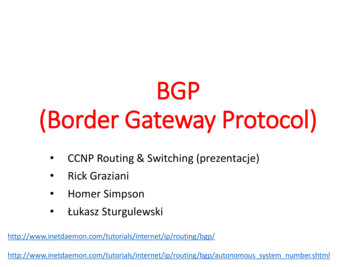
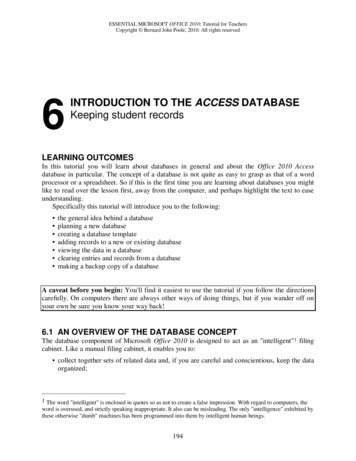
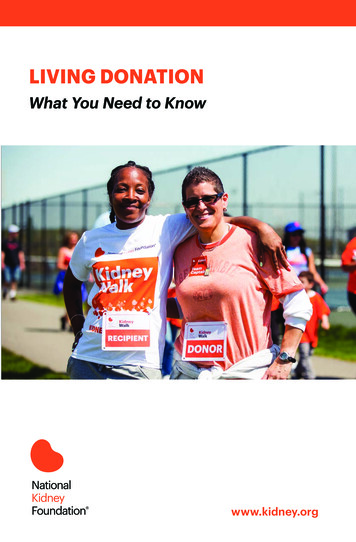
![[MS-OFBA]: Office Forms Based Authentication Protocol](/img/3/ms-ofba.jpg)
